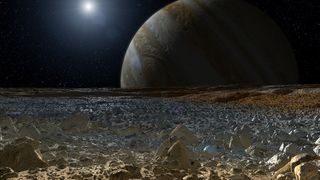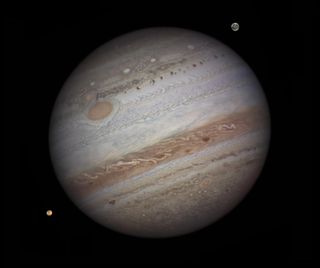Radio Signals from Jupiter Could Aid Search for Alien Life

Powerful radio signals that Jupiter generates could be used to help researchers scan its giant moons for oceans that could be home to extraterrestrial life, according to a recent study submitted to the journal Icarus.
Jupiter, the largest planet in the solar system, possesses 67 known moons, including three giant icy moons that might possess liquid oceans underneath their frozen surfaces. Astrobiologists want to investigate Europa, Ganymede and Callisto for extraterrestrial life, as there is life virtually wherever there is liquid water on Earth.

Of Jupiter's three largest icy moons, Europa, which is roughly the size of Earth's moon, is favored as having the greatest potential to sustain life. Magnetic readings captured by NASA's Galileo spacecraft provided compelling hints that it has an ocean, and radio scans by the probe suggest a water-rich layer beneath the surface between 50 to 105 miles (80 to 170 kilometers) thick. Recent findings even suggest its ocean could be loaded with enough oxygen to support millions of tons worth of marine life. [5 Bold Claims of Alien Life]
Scientists would like to analyze Europa's ocean directly, perhaps with missions to bore into Europa's icy shell using heat to melt through the ice, whirling blades to clear away rocks, and robot subs to explore the ocean. However, it remains uncertain how thick this shell is, complicating any plans to penetrate it. Models of its thickness, based on the amount of heat the shell receives from the sun and Europa itself, predict it to be roughly 18 miles (30 km) thick. In contrast, analyses of the Galileo spacecraft's data suggest the shell is no more than 9 miles (15 km) thick, and maybe as little as 2.5 miles (4 km) thick.
Ice-penetrating radar is currently the most promising technique to directly confirm the existence of any ocean hidden within Jupiter's icy moons. Radar works by transmitting radio signals, detecting any radio signals that reflect back, and analyzing these signals to deduce details about what they reflected off of, much like how a person might use a flashlight to illuminate objects hidden in the dark. Ice and ground-penetrating radar systems look for signals that indicate buried objects and boundaries between layers. In Europa's case, this means looking for the boundaries between the icy crust and any hidden ocean, and between such an ocean and Europa's rocky core.
To detect these oceans with ice-penetrating radar, low-frequency signals of less than 30 megahertz are needed to overcome radio wave absorption by the ice, as well as the unpredictable scattering of radio waves by the crinkled surfaces of these moons. The low-frequency radio waves that researchers would like to use are decametric, meaning they have wavelengths tens of meters long. [Photos: Europa, Mysterious Icy Moon of Jupiter]

One problem with attempting ice-penetrating decametric radar on Jupiter's moons has to do with the powerful decametric radio bursts coming from Jupiter itself. Altogether, these signals are more than 3,000 times stronger than any leaking into the solar system from the rest of the galaxy.
Get the Space.com Newsletter
Breaking space news, the latest updates on rocket launches, skywatching events and more!
Jupiter's decametric waves come from clouds of electrically charged particles trapped in Jupiter's magnetic field. To overcome Jupiter's loud radio signals, a mission probing Jupiter's moons would need a relatively strong transmitter, a massive device that might be difficult to power and fit aboard the limited confines of a spacecraft.
"If one were to treat the source for Jupiter's decametric emission as a transmitter, it is roughly producing the equivalent of a megawatt," said lead study author Andrew Romero-Wolf, a physicist at NASA's Jet Propulsion Laboratory in Pasadena, California. "It is certainly possible to generate a signal of that strength on Earth, but doing it in the vicinity of Jupiter is an entirely different challenge."
Instead of carrying a transmitter onboard a spacecraft to overpower Jupiter's radio signals, researchers now suggest using the giant planet's decametric radio waves to scan its moons.
"We can build our own transmitters to search for subsurface oceans with ice-penetrating radar, but when Jupiter is active, the radio emission is blinding to ice-penetrating radar,” said Romero-Wolf. “The technique we are developing could not only provide a solution to that problem, it could turn it into a strength."
All the mission would then need are very low-power systems to detect radio signals reflected by the moons and any oceans lurking within them.
"The great strength of this technique is that it doesn't need a transmitter, just a receiver," Romero-Wolf said. "A scanning system for subsurface oceans in icy moons potentially already exists. All we have to do is go there and listen."
The strategy that Romero-Wolf and his colleagues developed involves placing a spacecraft between Jupiter and one of its icy moons. The probe would then monitor decametric emissions from Jupiter as well as echoes of those signals reflected off the icy moon.
"The technology to do this is readily available and requires no major developments," Romero-Wolf said.
By comparing the signals from Jupiter with the echoes from its moon, the researchers can determine the thickness of the moon's icy shell and the depth of its ocean.
"I think this is one of those cases where a confluence of natural effects provides us with a probe for great science," Romero-Wolf said. "Jupiter not only hosts icy moons which could contain subsurface oceans, it is also an extremely bright radio emitter at decametric wavelengths. At these wavelengths, ice happens to be fairly transparent, providing a window to view subsurface oceans."
This strategy, where one analyzes both distant radio emissions and their echoes, is known as interferometric reflectometry. It was first applied by the Dover Heights radio observatory near Sydney, Australia, in the 1940s and was conceived due to the limited resources astronomers had available when the observatory first started out, not unlike the situation faced by designers of deep space probes.
Earth's atmosphere can interfere with traditional optical astronomy that focuses on visible light people can see with their eyes. However, the atmospheres of these icy moons are thin and are not expected to attenuate the decametric radio signal significantly.
"Europa does have an ionosphere, a layer of free electrons, which can distort the radio signal,” Romero-Wolf said. “However, this is also fairly small, and not expected to have a big impact on our ability to probe the ice layer."
The scientists now plan to make more detailed estimates of how well their radio strategy might detect hidden oceans in Jupiter's icy moons.
For instance, they are hoping to make observations from Earth of Jupiter's decametric radio emissions as they reflect off the icy moon surfaces.
"Our initial estimates indicate that this may be possible — the measurements would be close to the sensitivity of current ground-based radio observatories,” Romero-Wolf said. “If we can get this to work, it could provide valuable information about the surface properties of the moons."
He added that there are limitations to the technique.
"Unambiguous observation of a subsurface ocean or liquids in the ice of Europa is only the first step towards identifying the possibility for life,” he said. “What we are proposing will not be able to tell us whether there are living organisms in Europa, but it could provide strong evidence for that possibility."
This story was provided by Astrobiology Magazine, a web-based publication sponsored by the NASA astrobiology program.
Follow Space.com @Spacedotcom, Facebook and Google+.
Join our Space Forums to keep talking space on the latest missions, night sky and more! And if you have a news tip, correction or comment, let us know at: community@space.com.

Charles Q. Choi is a contributing writer for Space.com and Live Science. He covers all things human origins and astronomy as well as physics, animals and general science topics. Charles has a Master of Arts degree from the University of Missouri-Columbia, School of Journalism and a Bachelor of Arts degree from the University of South Florida. Charles has visited every continent on Earth, drinking rancid yak butter tea in Lhasa, snorkeling with sea lions in the Galapagos and even climbing an iceberg in Antarctica. Visit him at http://www.sciwriter.us

